A Broadwell Retrospective Review in 2020: Is eDRAM Still Worth It?
by Dr. Ian Cutress on November 2, 2020 11:00 AM ESTGaming Tests: Chernobylite
Despite the advent of recent TV shows like Chernobyl, recreating the situation revolving around the 1986 Chernobyl nuclear disaster, the concept of nuclear fallout and the town of Pripyat have been popular settings for a number of games – mostly first person shooters. Chernobylite is an indie title that plays on a science-fiction survival horror experience and uses a 3D-scanned recreation of the real Chernobyl Exclusion Zone. It involves challenging combat, a mix of free exploration with crafting and non-linear story telling. While still in early access, it is already picking up plenty of awards.
I picked up Chernobylite while still in early access, and was impressed by its in-game benchmark, showcasing complex building structure with plenty of trees and structures where aliasing becomes important. The in-game benchmark is an on-rails experience through the scenery, covering both indoor and outdoor scenes – it ends up being very CPU limited in the way it is designed. We have taken an offline version of Chernobylite to use in our tests, and we are testing the following settings combinations:
- 360p Low, 1440p Low, 4K Low, 1080p Max
We do as many runs within 10 minutes per resolution/setting combination, and then take averages.
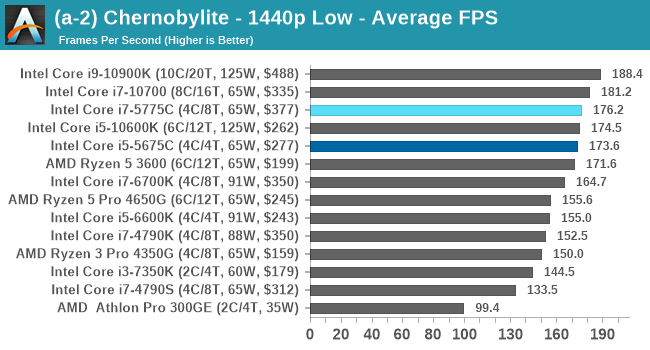
| AnandTech | Low Res Low Qual |
Medium Res Low Qual |
High Res Low Qual |
Medium Res Max Qual |
| Average FPS | 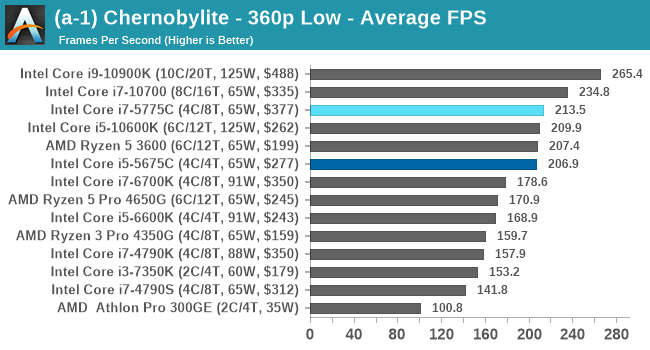 |
 |
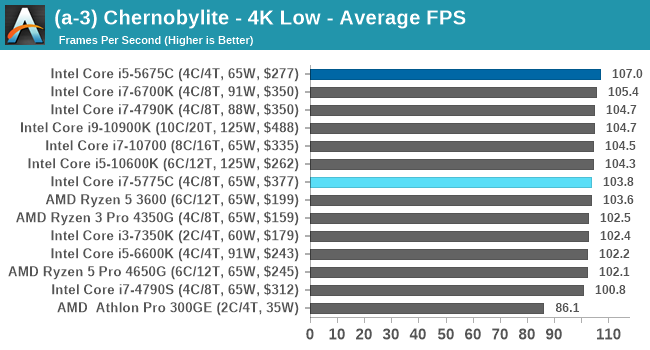 |
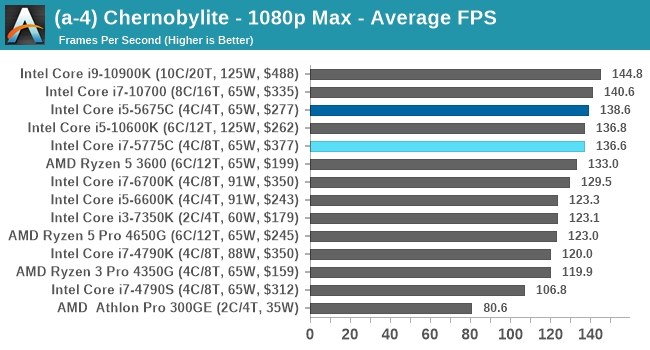 |
The Broadwell CPUs remain high performers here as the frame rates get cranked up, with the Broadwell Core i7+i5 even matching the latest Comet Lake Core i5, even at 1080p Max settings.
For our Integrated Tests, we run the first and last combination of settings.
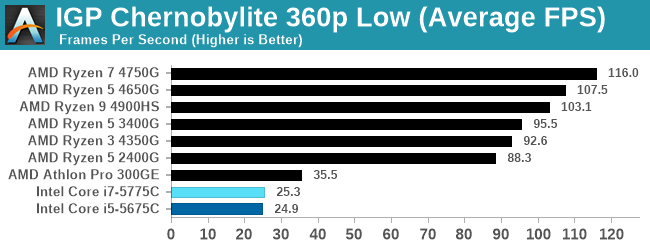
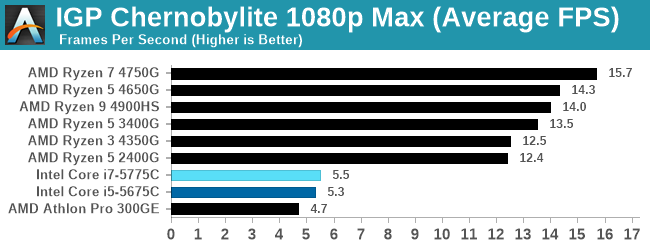
Integrated graphics shows how far AMD's basic options are ahead.











120 Comments
View All Comments
dotjaz - Saturday, November 7, 2020 - link
*servesSamus - Monday, November 9, 2020 - link
That's not true. There were numerous requests from OEM's for Intel to make iGPU-enabled XEONs for the specific purpose of QuickSync, so there are indeed various applications other than ML where an iGPU in a server environment is desirable.erikvanvelzen - Saturday, November 7, 2020 - link
Ever since the Pentium 4 Extreme Edition I've wondered why intel does not permanently offer a top product with a large L3 or L4 cache.lemmemakethis - Thursday, December 3, 2020 - link
Great blog post for better understanding <a href="https://farmslik.com/sales/">Buy rams near me </a>plonk420 - Monday, November 2, 2020 - link
been waiting for this to happen ...since the Fury/Fury X. would gladly pay the $230ish they want for a 6 core Zen 2 APU but even with "just" 4c8t + Vega 8 (but preferably 11) + HBM(2)ichaya - Monday, November 2, 2020 - link
With the RDNA2 infinitycache announcement and the increase (~2x) in effective BW from it, and we know Zen has always done better with more memory BW, so it's just dead obvious now that an L4 cache on the I/O die would increase performance (especially in workloads like gaming) more than it's power cost.I really should have said waiting since Zen 2, since that was the I/O die was introduced, but I'll settle for eDRAM or SRAM L4 on the I/O die as that would be easier than a CCX with HBM2 as cache. Some HBM2 APUS would be nice though.
throAU - Monday, November 2, 2020 - link
I think very soon for consumer focused parts, on package HBM won't necessarily be cache, but they'll be main memory. End users don't need massive amounts of RAM in end user devices, especially as more workload moves to cloud.8 GB of HBM would be enough for the majority of end user devices for some time to come and using only HBM instead of some multi-level caching architecture would be simpler - and much smaller.
Spunjji - Monday, November 2, 2020 - link
Really liking the level of detail from this new format! Fascinated to see how the Broadwell secret sauce has stood up to the test of time, too.Hopefully the new gaming CPU benchmarks will finally put most of the benchmark bitching to bed - for sure it goes to show (at quite some length) that the ranking under artificially CPU-limited scenarios doesn't really correspond to the ranking in a realistic scenario, where the CPU is one constraint amongst many.
Good work all-round 👍👍
lemurbutton - Monday, November 2, 2020 - link
Anandtech: We're going to review a product from 2015 but we're not going to review the RTX 3080, RTX 3090, nor the RTX 3070.If I were management, I'd fire every one of the editors.
e36Jeff - Monday, November 2, 2020 - link
The guy that tests GPUs was affected by the Cali wildfires. Ian wouldn't be writing a GPU review regardless, he does CPUs.